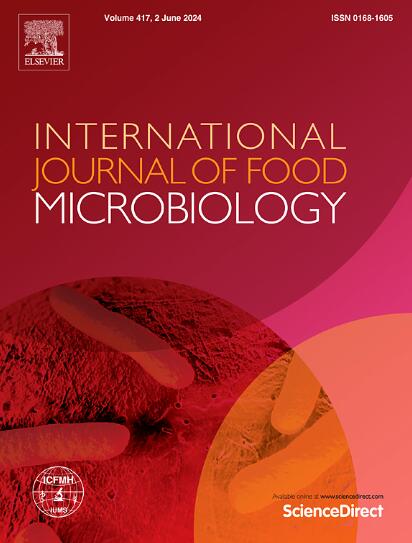在中国食源性金黄色葡萄球菌中,前噬菌体的转导促进了噬菌体耐药性干扰吸附的传播
IF 5
1区 农林科学
Q1 FOOD SCIENCE & TECHNOLOGY
International journal of food microbiology
Pub Date : 2025-05-16
DOI:10.1016/j.ijfoodmicro.2025.111271
引用次数: 0
摘要
虽然噬菌体已被证明是食源性金黄色葡萄球菌的有效生物防治剂,但噬菌体耐药性的传播导致噬菌体治疗效果降低的原因仍有待探索。本研究对91株中国食源性金黄色葡萄球菌进行了18种噬菌体对噬菌体的耐药性和吸附测定,并对噬菌体耐药基因的分布和传播进行了研究。91株金黄色葡萄球菌包括50株多药耐药菌株,均对两种以上噬菌体敏感。然而,9.9%(9/91)的金黄色葡萄球菌分离株对所有18种噬菌体都有耐药性,大多数噬菌体(83.3%,15/18)不吸附所有食源性金黄色葡萄球菌菌株。全基因组分析结果显示,91株分离菌株共含有101个噬菌体抗性基因,其中在原噬菌体中发现了24个基因(完整原噬菌体占19.8%,20/101;不完全噬菌体(16.8%,17/101)。值得注意的是,与其他分离的金黄色葡萄球菌温带噬菌体相比,成功诱导的SapYZUs631具有更好的生物学特性,包括更高的滴度(6.2 × 109 PFU/mL),更强的pH(4-11)和热稳定性(60°C 60 min),更广泛的宿主范围(80.2%,73/91)。SapYZUs631基因组含有噬菌体抗性基因tarP干扰吸附和毒力基因。SapYZUs631溶入金黄色葡萄球菌菌株YZUstau27、YZUstau31和YZUstau35后,噬菌体抗性增强,吸附减少。因此,我们的分析表明,吸附的中断是中国食源性金黄色葡萄球菌噬菌体耐药的主要原因,这是由于噬菌体通过噬菌体转导传播的结果。本文章由计算机程序翻译,如有差异,请以英文原文为准。
Prophage transduction promotes the transmission of phage resistance interfering with adsorption among Chinese foodborne Staphylococcus aureus
Although bacteriophages have proven to be efficient biocontrol agents for foodborne Staphylococcus aureus, the transmission of phage resistance resulting in the reduced efficacy of phage therapy remains to be explored. In this study, phage resistance and adsorption of 91 Chinese foodborne S. aureus isolates by 18 phages were estimated, and the distribution and transmission of phage resistance genes were investigated. The isolated 91 S. aureus comprised 50 multidrug-resistance isolates, all of which showed sensitivity to more than two phages. However, 9.9 % (9/91) of S. aureus isolates were resistant to all 18 phages, and the majority of phages (83.3 %, 15/18) did not adsorb to all foodborne S. aureus strains. Whole-genome analysis revealed that the 91 isolates comprised 101 phage resistance genes, including 24 genes were found in prophages (intact prophages, 19.8 %, 20/101; incomplete prophages, 16.8 %, 17/101). Notably, a temperate phage SapYZUs631 was successfully induced and exhibited better biological characteristics compared to other isolated S. aureus temperate phages, including higher titre (6.2 × 109 PFU/mL), stronger pH (4–11) and thermal (60 °C for 60 min) stability, and a wider host range (80.2 %, 73/91). The SapYZUs631 genome contained phage resistance gene tarP interfering with adsorption and virulence genes. The lysogeny of SapYZUs631 into S. aureus strains YZUstau27, YZUstau31, and YZUstau35 resulted in increased phage resistance and decreased adsorption. Therefore, our analysis suggests that the interruption of adsorption is the main reason for the phage resistance of foodborne S. aureus in China, which resulted from the transmission of phage resistance by prophage transduction.
求助全文
通过发布文献求助,成功后即可免费获取论文全文。
去求助
来源期刊
CiteScore
10.40
自引率
5.60%
发文量
322
审稿时长
65 days
期刊介绍:
The International Journal of Food Microbiology publishes papers dealing with all aspects of food microbiology. Articles must present information that is novel, has high impact and interest, and is of high scientific quality. They should provide scientific or technological advancement in the specific field of interest of the journal and enhance its strong international reputation. Preliminary or confirmatory results as well as contributions not strictly related to food microbiology will not be considered for publication.

 求助内容:
求助内容: 应助结果提醒方式:
应助结果提醒方式:


